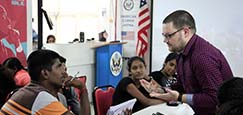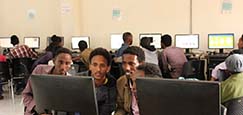ANNUAL REPORTS
TIMELINE
EMERGENCE OF BINATIONAL CENTERS, OVERSEAS LIBRARIES, AND AMERICA HOUSES
1920s – 1930s
During a period of isolationism in U.S. foreign policy, and in the absence of regular U.S. government support, Latin American elites, along with local U.S. residents and American non-governmental organizations, establish centers for the promotion of scholarly cultural exchange and English language teaching.
May 9, 1928
Instituto Cultural Argentino-Norteamericano, the oldest binational cultural institute still in operation (BNC), opens. It served as a model for the BNCs that followed.
Note: Occasionally, a U.S. diplomat would assist with facilitation of government permits, visas, etc. or with small amounts of in-kind assistance, but the State Department maintained a hands-off policy.
1937 – 1941
In the lead up to the United States’ entry into World War II, the State Department begins to increase funding for the BNCs, channeled through the American Council of Learned Societies and the American Library Association.
BNCs are founded in Brazil, Peru, Chile, Honduras, Uruguay, Argentina, Colombia, Ecuador, Venezuela, Cuba, and Mexico.
1943
The State Department’s Division of Cultural Relations increases financial support to BNCs, provided directly on behalf of the U.S. government.
1943 – 1947
The Pentagon’s Office of War Information opens and manages overseas libraries, called United States Information Service (USIS) libraries. USIS libraries open in the United Kingdom, Australia, New Zealand, India, and South Africa.
Libraries were also the core of a post-war network of “America Houses” in Germany that followed the BNC model. By 1948, there were as many as 60 America Houses and 137 smaller reading rooms in the American, British, and French-occupied sectors of Germany.
1947
The Truman Administration reorganizes the management of all 426 USIS libraries/reading rooms worldwide, placing them under the State Department.
Late 1940s
The State Department directly assists 27 independent and 20 branch cultural centers – all of them BNCs – in Latin America.
ESTABLISHMENT OF USIA
1953
At the onset of the Cold War and recognizing the importance of building mutual understanding between peoples to garner a positive view of U.S. society and its foreign policy goals, Congress merges all overseas public diplomacy spaces, USIS libraries/reading rooms, information programs, and the Voice of America to establish the United States Information Agency (USIA).
1960s – 1970s
Public Diplomacy posts in Europe, the Middle East, and the Pacific Rim are established, following the BNC model. These stand-alone facilities (located outside of a U.S. chancery or consulate’s main building) were the premier overseas public diplomacy platforms operated by the USIA. Regional Library Officers (also referred to as Regional Library Consultants) provided input and oversight into these platforms. However, by the end of the 1970s, the number of USIS libraries and Regional Library Officers had decreased due to USIA budget cuts.
USIA increases regular financial support for BNCs’ physical maintenance, programming, library materials, and English classes.
FROM AMERICAN CENTERS TO IRCs AND AMERICAN CORNERS
1980s – mid 1990s
In the early 1908s, the Reagan Administration provided an infusion of funding to USIS libraries. However, scrutiny from Congress, the Office of Inspector General, the then-General Accounting Office, and within USIA led to further budget cuts. USIS libraries are significantly downsized (in terms of materials and staff). In the mid-1990s, they are physically relocated into embassies as Information Resource Centers.
1996
Regional Library Officers transition to be Information Resource Officers (IROs) to reflect the position’s new role in advising IRCs on electronic information resources.
1999
USIA is integrated into the State Department. At this point, there are 190 USIA posts in 142 countries
Direct State Department funding for BNCs ends, except for their college counseling service, EducationUSA.
Early 2000s
BNCs continue to operate under their own funding with U.S.-educated executive directors. They begin to win U.S. accreditation for their English courses and sign agreements with U.S. testing services to offer TOEFL, SAT, and other college entrance exams. They also communicate regularly and meet biannually to share best practices through their informal association, The Association of Binational Centers of Latin America (ABLA).
Recognizing the popularity of the five American Centers in Moscow and other major Russian cities, U.S. Ambassador to Russia Jim Collins asks the Public Diplomacy section at the U.S. embassy to come up with a means to reach out to a broader range of the public in more remote areas, and the idea of American Corners is born. Eventually, there are 14 American Corners across the Russian Federation.
The American Corner model expands into neighboring countries: in Ukraine, Windows on America becomes the brand for its 29 American Corners. From the Newly Independent States of the former Soviet Union, American Corners expand into all geographic regions.
CONGRESS AND DEPARTMENT OF STATE LEADERSHIP RENEW INTEREST IN THE AMERICAN SPACES
2009
The Bureau of Western Hemisphere Affairs hosts the first ABLA meeting in Washington, D.C.
Senate Foreign Relations Committee member Richard Lugar (R – Indiana) places the It’s Time to Get Back in the Game. It documents the many American Spaces available for more robust use and urges the State Department to develop a strategy while adhering to security standards.
Secretary of State Hillary Clinton undertakes the first Quadrennial Diplomacy and Development Review (QDDR), which charts the path for increased use of American Spaces in achieving public diplomacy goals.
In response to the QDDR, Under Secretary for Public Diplomacy and Public Affairs Judith McHale initiates the Strategic Framework for Public Diplomacy. Working groups conclude that American Spaces should be considered a single set of assets and should offer a common menu of programs and information which, combined, would form a common experience of America for foreign audiences.
By this time, there are over 400 American Corners worldwide.
OFFICE OF AMERICAN SPACES ESTABLISHED
2011
The Office of American Spaces is established in the Department of State’s Bureau of International Information Programs (IIP).
2014
IIP invests more funds, human capital, and training into what it identifies as strategically located American Spaces, resulting in a transformation of over 40 facilities into modern 21st-century programming platforms that offer a welcoming, distinctly American environment, policy-relevant programming, trained staff, and modern technologies.
2017
IROs’ title transitions to Regional Public Engagement Specialists (REPS), with a broader focus on communications.
IRCs transition in name, function, and design to American Centers.
2019
The Office of American Spaces moves to the Bureau of Educational and Cultural Affairs (ECA).
2020
The Office of American Spaces spearheads efforts to modernize and standardize the global network —including the delivery of more online training and programming to allow for both in-person and virtual participation, leveraging private sector support.




